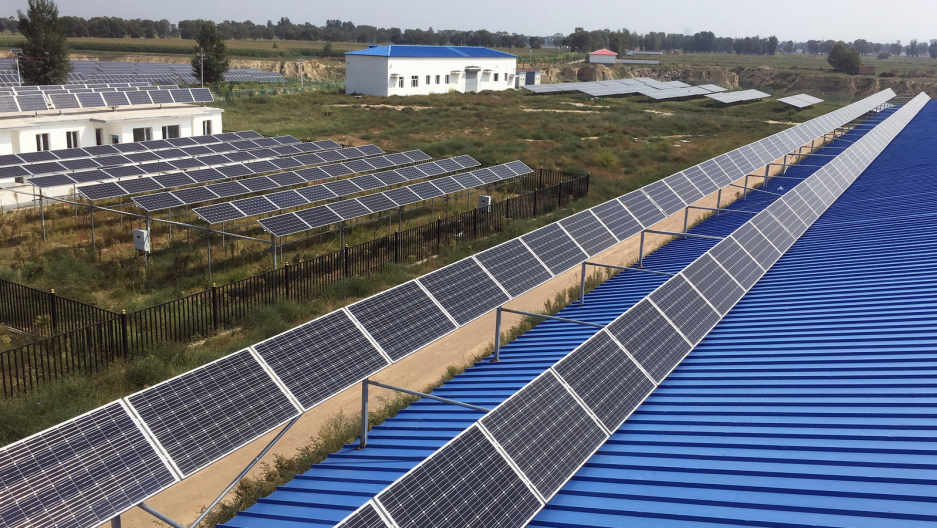By TIM FAULKNER/ecoRI News staff
Some farmers see wind
turbines and solar fields as a boost to their modest and often unpredictable
income.
They say renewable energy can keep a farm practicing traditional agriculture instead of being forced to sell farmland — a tempting option given that Rhode Island farmland is the most expensive in the country.
They say renewable energy can keep a farm practicing traditional agriculture instead of being forced to sell farmland — a tempting option given that Rhode Island farmland is the most expensive in the country.
“It’s been very difficult to make a living farming,” said Bill Stamp of Stamp Farms in Cranston and Exeter. “You need to advent change to survive.”
Stamp spoke at a recent
hearing for a proposed rule change to the state program that gives farmland a
break on property taxes.
The proposed rule, passed by the General Assembly in
2017, allows farms in the Farm, Forest and Open Space program to install
wind and solar projects on 20 percent of their land without triggering a
land-use tax, a process called “dual use.”
Not all farms are
allowed to install commercial-scale solar and wind, meaning they generate
revenue by selling the renewable electricity a farm doesn’t use for its own
needs.
Any open space protected by a state conservation easement or through the sale of its development rights is prohibited from installing utility-scale wind and solar projects.
Any open space protected by a state conservation easement or through the sale of its development rights is prohibited from installing utility-scale wind and solar projects.
Andrea Panciera of Russet
Valley Farm, a 230-acre hay and beef cattle farm in Hopkinton, supports dual
use on protected land where the development rights have been sold. She sees
local farmers installing solar on land that isn’t protected and wants the same
option.
“If you can do this on
one farm, I think you should be able to do it on all farms,” Panciera said.
Renewable energy is just
another form of farming, she said. “Alternative-energy structures are
harvesting, farming, solar farms, and energy.”
This debate is playing
out in rural communities such as Hopkinton and cities
with large pockets of open space such as Cranston. Municipalities
have the final say in siting regulations, but the state is trying to establish
standard rules by holding public hearings to set solar guidelines that
communities can adopt as their own.
A bill to make the process mandatory passed the state House of Representatives this year but was never heard by the Senate.
A bill to make the process mandatory passed the state House of Representatives this year but was never heard by the Senate.
Tess Brown-Lavoie of
Sidewalk Ends Farm on the city’s West Side worried that increasing the 20
percent threshold would reduce the amount of prime farmland in the state and
make farming more prohibitive for newer farmers who typically lease land. Young
farmers, Brown-Lavoie said, wouldn’t have the benefit of renewable-energy
revenue.
Loren Thurn of
Our Kids Farm in Exeter wanted the changes to allow unfarmed land such as
woodlands to be included in the percentage of land eligible for solar and wind
projects. He supported growing crops, such as potted plants, and keeping
livestock on land under and around solar arrays.
“It’s something we need to do a lot more research on. It’s a very definite part of our future,” Thurn said.
A letter submitted by
the American Farmland Trust, Audubon Society of Rhode Island, Conservation Law
Foundation, Rhode Island Land Trust Council, Land For Good, and Save The Bay
requested several changes to the proposed rule.
The group has asked the Rhode Island Department of Environmental Management (DEM), or conservation districts, to perform annual reviews of conservation plans, which are required to receive the state farm and open space designation.
The group has asked the Rhode Island Department of Environmental Management (DEM), or conservation districts, to perform annual reviews of conservation plans, which are required to receive the state farm and open space designation.
Currently, no entity
checks on whether farms are complying with their conservation plans and there
are no set standards for what is required in a conservation plan, according to
the letter.
The environmental groups
asked that buffers, access roads, and infrastructure for renewable-energy
projects be included in the 20 percent land-use calculation.
They noted that vegetation, not crushed stone, should be grown around and under renewable projects. They suggested that the projects limit disruption to farmland and open space and the landscaped buffers make the land appear natural to neighbors.
They noted that vegetation, not crushed stone, should be grown around and under renewable projects. They suggested that the projects limit disruption to farmland and open space and the landscaped buffers make the land appear natural to neighbors.
Ken Ayars, chief of
DEM’s Division of Agriculture, said the point of the new rule is to support
both agriculture and renewable energy.
“Finding that balance is
very important but ultimately we cannot allow degradation of the underlying
soil and lose its capacity to be a viable farm,” Ayars said.
The comment period for
the proposed rule changes ended Oct. 24. DEM can now file the new rules with
the secretary of state, file the rules and regulations with minor changes,
don’t file the rule changes and let the exiting rule stand, or make new changes
and hold another public hearing.
